 Click to enlargeThe bell is about to ring for the first time for the upcoming school year, meaning maladies, ailments and other health nuisances are coming soon.
Click to enlargeThe bell is about to ring for the first time for the upcoming school year, meaning maladies, ailments and other health nuisances are coming soon.
One of those annoyances comes in the form of head lice — itchy, bothersome, parasitic insects that live solely on the scalp hair of humans and usually on children 10 and younger. As do all insects, head lice develop in stages from egg, or nit, to nymph and finally to louse.
There are many fallacies about lice, says D’Ann Somerall, DNP, an assistant professor and family nurse practitioner specialty track coordinator in the University of Alabama at Birmingham School of Nursing. The biggest misconception, Somerall says, is that lice are a problem only for the poor.
“It has nothing to do with how clean or dirty your home or school may be, or how clean or dirty your kids may be,” Somerall said. “Affluent schools, rural schools, urban schools — anyone from any socioeconomic background can get head lice, no matter how clean their hair or home.”
Somerall, a mother of six children, experienced firsthand the issues lice can create in her own home. Her oldest daughter came home from school one day and was violently scratching the back of her head. When Somerall first looked, she believed it was dandruff. A closer inspection revealed that it was actually nits, the eggs lice leave behind.
“My daughter has really thick hair, and when we pulled it up and looked, she had probably thousands of nits in her hair,” Somerall said. “Of course I was mortified at first. I had no idea she had them. But it is not something parents should panic about. You can take care of it. It is tedious because treatment can play out over the course of days and weeks, but it can be done. The main thing is to recognize, identify and treat as soon as possible.”
The first sign that lice may be an issue is bad itching on the nape of the neck and behind the ears. Children with long, thick hair also are more prone to acquire lice. The bugs are more difficult to see than the nits, which can be white or dark. If they are dark, it means the louse is inside of the egg. If nits are white, it means the louse has hatched.
Because the nits are bloodsuckers, they are typically found one-quarter of an inch from the skin. The louse itself is hard to find in part because of its size and because it travels quickly, moving up to nine inches in one minute.
Somerall says all infested persons and their bedmates should be treated at the same time. Rid and Nix are popular over-the-counter medications used to treat lice; but if crawling lice are still seen after a full-course treatment, it is recommended that you contact your health care provider. Parents with children age 2 and younger should call their pediatrician before using any over-the-counter treatment for lice.
Home remedies to treat lice, including the use of mayonnaise, vinegar or petroleum jelly in the hair and covering with a shower cap for several hours or days, do not work, according to the Centers for Disease Control. However, Somerall says one of the home remedies did work for her daughter.
“It was a moment of desperation, really, because we used over-the-counter products to treat, and we thought they were all gone until a hairdresser found them again while my daughter was getting her hair cut,” Somerall said. “We covered her head in Vaseline and put a shower cap on for eight hours, and it did get rid of them.”
Somerall also says to use a lice comb on your child’s hair as directed, including after you get rid of the lice.
“It’s best to use a metal comb instead of a plastic one,” Somerall said. “Remember that lice infestation can be an ongoing battle, especially in group settings. There’s no doubt that they can be hard bugs to get rid of, so being persistent and following the directions of the medications used to treat your child’s hair is key.”
If you suspect your child does have lice, Somerall says you should check with the school nurse or child care center director to see if other kids have recently been treated for lice. If you discover that your child does have lice or nits, contact the staff at the school or child care center to let them know and to find out what their return policy is.
More information on the treatment of lice is available at www.cdc.gov.
